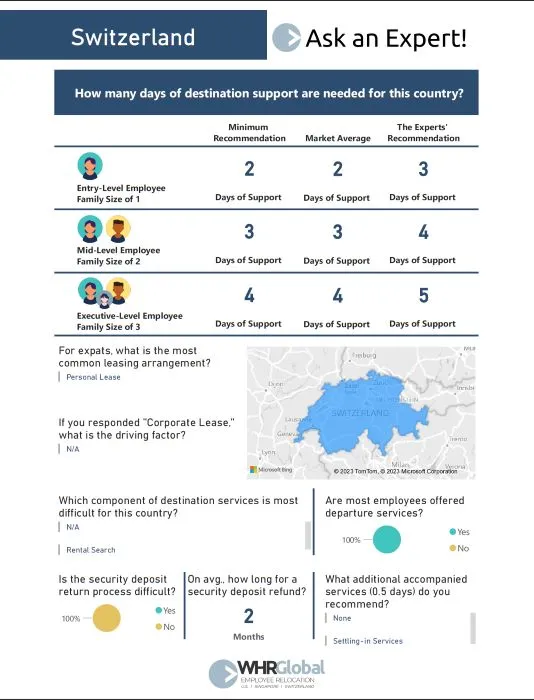
您的组织是否在战略上协调了全球流动和人才招聘利益相关者?或者您的团队是否感到各自为政,有着不同的优先事项和理解?请阅读以下内容,了解协调全球人才流动和人才招聘团队的 6 种方法,包括曾在霍尼韦尔和通用电气工作的全球人才流动和移民领导者 Reda Belabed,以及 WHR 全球战略计划经理 Sean Thrun 的见解。
如果你觉得你的全球人才流动团队和人才招聘团队没有朝着同一个目标努力,那么你并不孤单!幸运的是,您可以采取几个常识性步骤来改进您的人才流动,并确保这些利益相关者作为一个有凝聚力的团队开展工作。
当全球人才流动和人才招聘团队协调一致时,您就能快速、合规地聘用高度专业化的员工。
1.向核心地点的全球流动和人才招聘团队分发 "如何 "搬迁指南
向人才招聘和全球流动团队分发 "如何做 "指南。这些应该是他们必须了解的公司核心地点的关键任务,包括移民、税务和建议的异地支持。 例如
-
-
- 贵公司经常聘用高管到荷兰全球卓越中心工作。您的团队是否正在申请荷兰的 30% 法规?贵公司的人才招聘团队是否负责确保每位应聘者在递交工作申请之前符合 30% 法规的要求?例如,您的人才招聘代表必须确保应聘者具有特定的专业知识,招聘地点距离荷兰边境超过 150 公里,等等。
- 您的人才招聘团队是否熟悉美国签证类型,例如用于公司内部调动的 L-1 签证或用于特殊职业的 H-1B 签证?在尝试寻找外国人才之前,您的人才招聘团队应该了解每种签证类型的基本要求。
- 您的 RMC 应主动指导您的核心地点在不同国家所需的迁居支持水平。例如,这份《2023 年目的地服务基准报告》按国家、家庭规模和员工级别列出了最低、平均和建议的目的地支持水平。报告还指出了个人租赁还是公司租赁、需要多长时间才能收到押金返还,以及哪些部分最具挑战性。
-
2.审查人才招聘指标,如 "填补时间"(Time-To-Fill)。
遗憾的是,TA(人才招聘)的衡量标准不仅是职位填补的数量/质量,更主要的是填补时间(TTF),这往往会扩大组织需求、候选人经验和严峻的合规现实之间的关键差距。
在法律允许的情况下,我对所谓的 "移民聘用能力 "实施了跨职能预评估程序。在采用这种方法的地方,我对这种方法能够提高两个职能部门之间的合作水平(并最终降低 "糟糕雇佣 "的风险)感到非常满意。 在其他地方,数据隐私法规和公平就业做法似乎是实施的障碍。在劳动与就业方面,通过劳资协议会等方式,灵活性并不高,这确实是一个挑战。
在这些情况下,我们一直关注的一个问题是增加(和重复)对招聘人员的培训和教育课程,让他们尽快了解 "他们需要注意什么/如何识别红旗",并审查整体沟通策略(直到接受录用),使所有利益相关者能够更好地了解以移民身份和/或担保要求和责任(包括成本、时间表、移民生命周期以及人才管理策略)雇用候选人的潜在风险。
我想我们都在不断进步,但距离我们对合作和伙伴关系的满意度、100% 的候选人满意度、更好的 TTF 指标以及令人满意的聘用前移民合规评估,还有很长的路要走。
3.实施预录取检查点,提高成功率
如上所述,流动计划可以通过实施各种接受前检查点来大大提高任务的接受率和成功率。
-
-
- 聘请信誉良好的税务公司提供服务。除了为外派人员提供国家情况介绍外,他们还能为人才招聘团队提供宝贵的指导。至少要确保您的人才招聘团队熟悉税务协助、 均等化和总额化协议的概念。为所有外国申请人提供接收前税务简报。
- 对于特定国家的税务简报,申请人应在接受职位前了解自己的选择,因为任何误解都会大大增加调职或外派失败的风险。外派人员(尤其是担任行政或总监级别职位的人员)可能拥有复杂的投资组合,包括股票、股票期权、债券、房地产、黄金等贵金属。员工的选择会因工作地点、国籍和异地安置类型(长期调动、长期外派、短期外派、通勤、商务旅行)的不同而有很大差异。
- 如上文第 2 步所述,在法律允许的情况下,建立自己的跨职能预评估流程(又称移民雇佣能力指南)。不过,您应注意美国和欧盟等具有挑战性的司法管辖区,Reda Belabed 对此做了进一步详细说明:
-
在美国等国家,问题可能仅限于 "您是否或将来是否需要担保",而在其他欧盟国家,要求提供个人信息/数据可能被视为个人隐私,有碍公平就业/招聘歧视。中东(尤其是海湾合作委员会)等地区对这些评估更为开放。
长期以来,外籍员工和多元化员工一直是招聘部门的工作重点,它们往往允许/提倡根据担保要求进行可雇佣性审查,但同时也提倡提高 "配额 "的透明度。这并不是说国籍配额是一件值得宽容的事情,但其透明度有助于预先确定可行性--而不是与候选人接触到录用阶段才发现可能无法录用。从组织的角度来看,这个过程是相当透明和简化的。
4.通过您的迁居管理公司 (RMC) 进行决策前通话
您的全球人才流动团队和 RMC 也可以选择实施决定前电话。在迁居管理中,决定前电话可确保候选人了解他们将获得的迁居方案。不过,这也是您的 RMC 宣传贵公司和福利待遇的机会,可以减轻员工或家属的顾虑。
决定前电话还能防止员工在接受聘用并开始迁居流程后产生分歧或误解。例如,在决定前电话会议之后,员工就能清楚地知道他们将获得哪套安置方案,每项安置津贴是多少等等。通常情况下,人才招聘或人力资源业务合作伙伴报价的迁居方案与 RMC 实施的迁居方案之间存在脱节。这可能归结为人为失误,也可能是某个人在执行旧的/过时的政策。如果 RMC 在作出决定前解释异地安置方案,并在接受后执行异地安置方案。.

5.优化人力资源信息系统,实现最大程度的人才流动
贵组织可以通过在 HRIS(人力资源信息系统)中创建自定义字段、对象和报告,最大限度地提高人才的流动性。例如,在 ADP 中,企业可以建立并管理一个人才库,其中包括愿意为空缺职位进行异地调动的求职者。但是,企业也不应忽视愿意为公司内部调动而异地工作的现有员工。现有员工应该了解您的产品、服务和期望,从而降低招聘和培训成本。
根据SHRM 基准,聘用一名高管的平均成本为 28,329 美元。然而,许多雇主估计,招聘一名新员工的总成本可能是该职位工资的三到四倍。这既包括招聘人员等硬成本,也包括部门领导和经理为招聘和培训过程提供支持所花费的时间等软成本。
与其从头开始寻找新的候选人,不如与 IT 部门沟通,在人力资源信息系统中添加自定义字段、对象和报告。然后,现有员工可以在他们的人力资源档案中说明他们是否愿意为新职位进行异地调动。在自定义报告中,您还可以添加筛选器,结合人力资源信息系统中已加载的过往绩效回顾,将人才库缩小到愿意异地工作的高绩效员工。

6.与人才招聘团队定期举行培训会议
定期的培训课程可确保您的人才招聘团队能够使用相同的系统、资源,并回答候选人在接受前和接受后经常提出的问题。培训课程还为人才招聘团队的新成员提供了一个机会,让他们了解更多关于员工正在接受的流动一揽子计划的信息,并强化所有人才招聘团队都应遵循相同的标准化流程的信息。
迁居管理公司会定期为人才招聘团队和相关利益方安排培训课程,以提高人才的流动性。这些培训课程可包括
-
-
- 异地安置管理公司为流动、助教和人力资源团队提供的现场培训课程。根据流动项目的规模,异地安置管理公司可能会免费提供这些培训课程,或者只要求贵公司承担酒店和差旅费用(取决于距离和持续时间)。
- 区域管理中心的虚拟网络研讨会式培训课程。
- 为贵组织的关键地点或存在特殊困难的地点提供针对特定国家或地区的培训。
- 目的地服务提供商(DSP)和租赁代理对市场最新情况、文化规范和最佳实践的见解。
- 移民公司就红旗、配额、预计时限、最低工资、劳动力市场测试要求等提供指导。
-
我们通过定期为人才招聘负责人举办培训课程,在将地区结构过渡到集中式全球流动计划方面取得了巨大成功。这些课程主要侧重于整个过程中的旅程地图和关键考虑因素。通过让地区 TA 利益相关者积极参与有关流动效益和预期成果的讨论,我们发现他们采用标准化流程的意愿明显增强。
总之,调整全球流动和人才招聘团队对于企业确保高效招聘和成功的人才流动至关重要。通过分发异地工作指南、审查人才招聘指标、实施接收前检查点、进行决策前电话沟通、优化人力资源信息系统以及开展定期培训课程,企业可以促进这些团队的合作并提高其效率。实现协调统一有助于迅速、合规地聘用专业员工,降低风险,改善招聘时间指标,并最终提高应聘者的整体满意度和移民合规性。在协调这些团队方面的持续努力和投资将有助于实现更简化、更成功的人才招聘流程。

